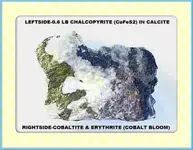Thanks very much everyone...I apologize for a late response...been sidetracked over the weekend.
Al... its been quite a long time since we've talked, a special thanks to you for taking a moment to post your kindly comments.
Bartholomewroberts...I think galena type ores could be much more difficult to detect even using all-metal modes. I have quite a number of galena samples, some half-dollar samples will respond out to a few inches, and others...especially character pieces... don't respond as well. Possibly the amount of silver mixed-in would improve ore detectability...thats a guess... as I have no experience detecting those ores.
Tuberale...your questions:
1) Have you not come across any ferrous-nickel targets? Do you search for such targets?
Any target that will respond to VLF all-metal motion mode or PI units gets my attention. The only nickel related mineral that I know responds very well to these units in these parts is a nickel arsenide called "niccolite" or possibly may be known as nickeline in other areas. It tarnishes quickly to the same color as a tarnished copper penny, is quite heavy and brittle. With weathering it oxidizes to a green mineral called "annabergite". See the photos below...
2) Have you ever done acetic acid liberation of native silver from calcite? I think the results of such liberation might be visually stimulating. Your comments on total silver content in rock sample suggest you have either already done such work ... or have spent some time doing specific gravities.
I have done both extensively for many years. Acetic acid is a mild method for removing calcite without damaging more fragile silver whereas a solution of muriatic acid...around here that is about 37% hydrochloric acid (HCl)...mixed at roughly one part to three parts water is the usual acid wash treatment when required to expose silver. Nowadays I rarely use it for more than removing a very thin layer of calcite.
3) This is a fascinating area! Are you uncovering other noteworthy mineral specimens here?
Yes...there are many other minerals in the area for collectors such as cobaltite and its oxidation mineral "erythrite, niccolite and annabergite as mentioned above, chalcopyrite is abundant, serpentine, various sulfides of silver including acanthite and various ruby silvers, pyrrhotite...a conductive iron sulfide, etc. The list goes on... but these are the ones that are found rather easily visually or otherwise respond to a metal detector.
Thanks Tuberale for showing such an interest in this topic...

Jim.











